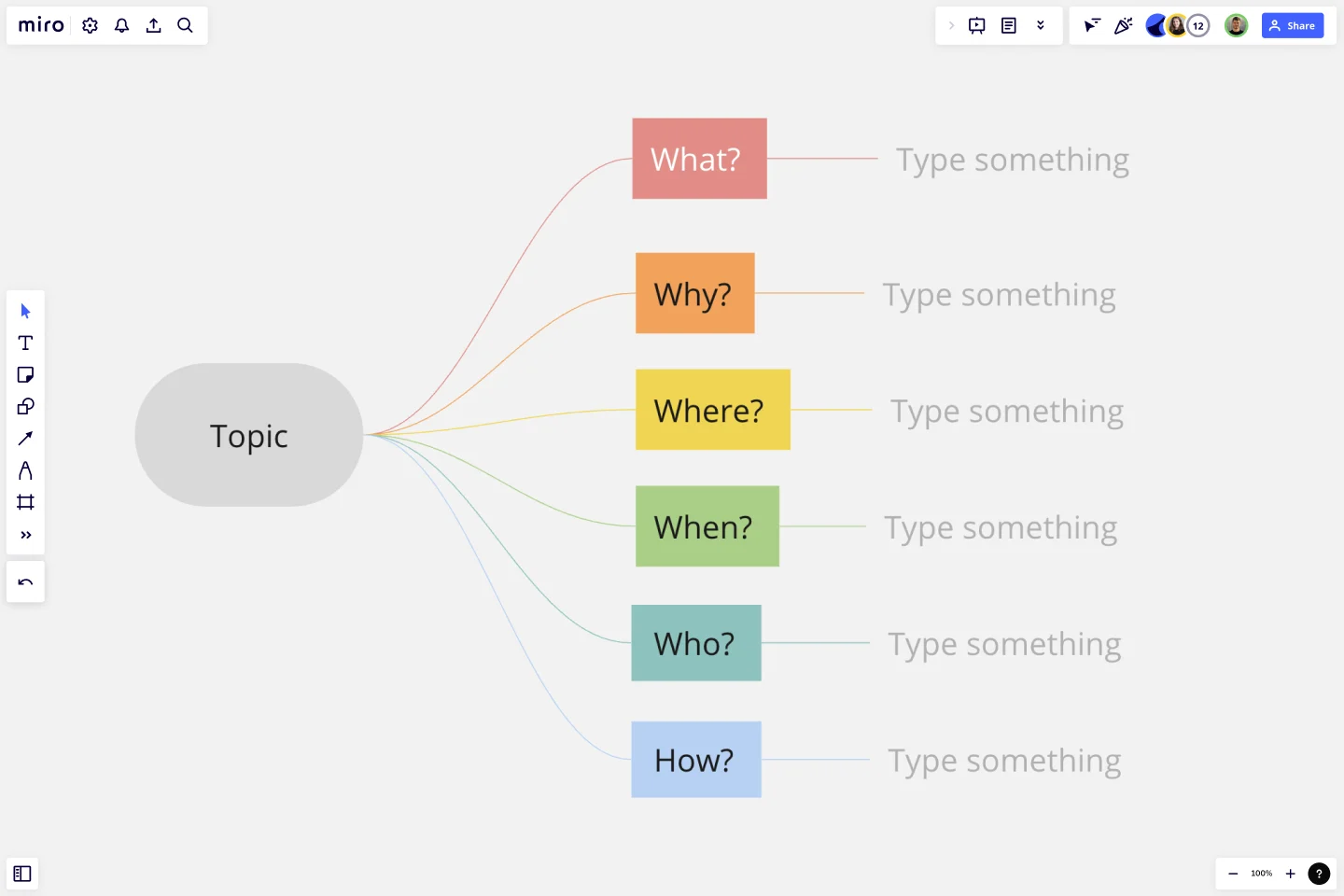5W1H Template
Use the 5W1H Template to promote structured thinking. By methodically addressing these core questions, teams can eliminate oversights and ambiguities, leading to more informed decisions and a clearer path to achieving their objectives.
Trusted by 65M+ users and leading companies
About the 5W1H Template
The 5W1H Template is a dynamic tool at the intersection of collaboration and structured thinking. Universally recognized, this method offers clarity and direction to any project or challenge. By systematically addressing each of the core questions, teams can streamline their approach, ensuring alignment and understanding from inception to completion.
What's a 5W1H Template?
The 5W1H Template stands for "What, Who, Where, When, How, and Why." It's a foundational framework used for problem-solving, planning, and decision-making. By answering these six fundamental questions, teams can gain a holistic understanding of a situation, project, or problem, ensuring thoroughness and clarity in their approach.
One significant benefit of using the 5W1H Template is that it promotes structured thinking, preventing oversight and ensuring that every aspect of a situation or challenge is considered. This comprehensive view minimizes misunderstandings, mitigates risks, and facilitates effective communication among team members, stakeholders, or any involved parties.
How to use the 5W1H Template: A quick guide
Begin with 'Who': Start by identifying the key stakeholders, team members, or parties involved. This step ensures everyone pertinent to the situation or project is considered from the outset.
Define the 'Where': It's crucial to set the context here. Depending on your project, this could be a physical location, a digital platform, or a conceptual space.
Specify 'When ': Indicate the time, be it a specific date, a timeframe, or a recurring schedule. If there's a deadline, this is the place to note it.
Detail the 'How': Describe the methods, tools, or processes that will be implemented. This is where the mechanics of the project or solution are elucidated.
Clarify the 'Why': This might be the most crucial step. Addressing the 'Why' means delving into the motivation, purpose, or reasoning behind the action or situation. It's the driving force that often determines the success of a project.
Use Miro's automated diagramming features: As you flesh out your analysis, you might find the need to expand sections or delve deeper into specific points. Miro's automated diagramming capabilities allow you to extend the template easily, accommodating additional content or complex relationships.
Collaborate in real time or async: One of the strengths of using Miro is the capability to collaborate seamlessly. Invite team members to your board, allowing them to contribute in real time for immediate feedback or asynchronously to accommodate different schedules and time zones.
By systematically addressing each component of the 5W1H framework, you ensure a holistic understanding of your project or problem and foster effective team collaboration and communication. Whether working synchronously or asynchronously, the combined clarity of the 5W1H approach and the versatility of Miro's features set your team up for success.
Can I customize the 5W1H Template in Miro?
Yes, Miro's templates are designed to be flexible. You can change sections, colors, and layouts to fit your team's specific needs.
How can I share my 5W1H analysis with non-Miro users?
Miro offers various export options. You can share your board as a PDF, image, or even grant view-only access to those without a Miro account.
Is there a limit to how many people can collaborate on a 5W1H board?
With Miro's premium plans, there's no limit to how many team members you can invite. Everyone can collaborate and contribute in real time.
Can I integrate the 5W1H Template with other tools?
Yes, Miro integrates seamlessly with popular tools such as Slack, Trello, and Asana, making incorporating your 5W1H analysis into your broader project management strategy easier.
Get started with this template right now.
Workshop Planner
Works best for:
Planning, Strategy
Workshop Planner template helps you organize and plan effective workshops. It allows you to outline activities, set timelines, and allocate resources, ensuring your workshops run smoothly and achieve their objectives.
Spider Diagram Template
Works best for:
Diagramming, Mapping
Perfect for brainstorming sessions, project planning, or simply organizing thoughts, the Spider Diagram Template allows you to create 'legs' branching out from a central idea, representing related topics or subtopics.
Timelining
Works best for:
Planning, Timeline
Timelining is a versatile template designed for creating detailed project timelines. It allows you to outline tasks, milestones, and deadlines, helping you manage projects efficiently. Whether for business or personal use, this template ensures you stay organized and on schedule.
OKR Planning Template
Works best for:
Strategic Planning, Meetings, Workshops
The OKR Planning template helps you turn exhaustive OKR sessions into dynamic and productive meetings. Use this template to make OKR planning more interactive, guiding your team through the session with creative Ice Breakers and Brainstorms, so you can co-create your OKRs and define the key results and action plans to achieve them.
Gantt Chart Project
Works best for:
Strategy, Planning
The Gantt Chart Project template is a versatile tool for managing various types of projects. It provides a clear visual timeline of your project's tasks, deadlines, and dependencies. Use it to plan, execute, and monitor your project's progress, ensuring all activities are aligned and on track. This template enhances team collaboration, improves time management, and helps address potential bottlenecks for successful outcomes.
Balanced Scorecard Template
Works best for:
Operations, Strategic Planning, Project Planning
Balanced scorecards are useful tools for understanding business performance at a glance with regard to customers, employees, business processes, and financial progress. Learn more about BSCs and create your own using Miro’s Balanced Scorecard template.
